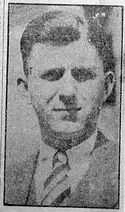Laurence McKinley Gould
| Laurence McKinley Gould | |
|---|---|
 | |
| Laurence McKinley Gould | |
| 4th President of Carleton College | |
| In office 1945–1962 | |
| Preceded by | Donald Cowling |
| Succeeded by | John Nason |
| Personal details | |
| Born | August 22, 1896 Lacota, Michigan, U.S. |
| Died | June 21, 1995 |
| Nationality | American |
| Alma mater | University of Michigan |
Laurence McKinley "Larry" Gould (August 22, 1896–June 21, 1995) was an American geologist, educator, and polar explorer.
Biography
Gould was born in Lacota, Michigan on August 22, 1896. After completing high school in South Haven, Michigan in 1914, he went to Boca Raton, Florida and taught grades 1 to 8 in a one-room school for two years, while saving money for college. He enrolled at the University of Michigan in 1916, but interrupted his education the following year to enlist in the U.S. Army following U.S. entry into World War I. He served in the Army until 1919, when he returned to the university to resume his studies.
After graduating in 1921 with a B.S. degree in geology he joined the University of Michigan faculty as a geology instructor while continuing his studies there. During his undergraduate days, he was the founder of the Beta Tau Chapter of the Pi Kappa Alpha Fraternity. He also was an active member in the university Society of Les Voyageurs. He received an M.A. degree in 1923 and a D.Sc. degree in 1925, with a dissertation on the geology of Utah's La Sal Mountains, and he advanced to assistant professor in 1926, and to associate professor in 1930.
In the summer of 1926 Gould undertook his first trip to the Arctic, serving as assistant director and geologist with the University of Michigan Greenland Expedition. The following summer he was geographer and topologist for George P. Putnam's expedition to survey the coast of Baffin Island in Arctic Canada.
During 1928 to 1930 he accompanied Admiral Richard E. Byrd on Byrd's first expedition to Antarctica, serving as the expedition's chief scientist and second-in-command. On November 4, 1929 Gould and five companions began a grueling 2½ month, 1500-mile dog-sledge journey into the Queen Maud Mountains, with the primary purpose of providing ground support and possible emergency assistance for Byrd's historic first airplane flight over the South Pole and a secondary purpose of conducting the first geological and glaciological survey of an area that Gould called "a veritable paradise for a geologist."[1] After the successful flight over the Pole in November 1929, Gould and his companions climbed Mount Fridtjof Nansen to investigate its geology. The layered sandstones that Gould found in outcrops at the mountain's peak helped confirm that Antarctica was linked geologically to the Earth's other continents.
The expedition's progress had been reported regularly in the news media, and when the members of the expedition returned to the United States on July 19, 1930, they received a hero's welcome. Recognitions that Gould received upon his return included a Congressional Gold Medal, the 1930 David Livingstone Gold Medal of the American Geographical Society, and a Medal of the Mayor's Committee of the City of New York.
On August 2, 1930, two weeks after returning from Antarctica, Gould was married to Margaret ("Peg") Rice in Ann Arbor, Michigan. She had been a student in one of his classes at the University of Michigan, .
In the months and years after returning from Antarctica, Gould traveled around the country giving lectures on the experience. His 1931 book Cold: the Record of an Antarctic Sledge Journey described the dog-sledge trek, recalling blinding blizzards, snow bridges that collapsed into deep crevasses, and weather so cold that it nearly froze a person's eyelids shut. Additionally, he published several scientific articles about the findings of the Byrd expedition.
In 1932 Gould accepted a position as full professor and chairman of the geology department at Carleton College, so the Goulds moved to Minnesota. "Larry" Gould was a popular professor at Carleton and was named president of the college in 1945, holding that position until 1962. In 1963 he retired to Tucson, Arizona and taught Glaciology at the University of Arizona.
He also served as President of the American Association for the Advancement of Science.
During his lifetime, Gould was the recipient of 26 honorary degrees.[1] In 1995 Carleton College renamed its college library the Laurence McKinley Gould Library in his honor. The R/V Laurence M. Gould, a 76-m-long ice-strengthened research ship built in 1997 for the National Science Foundation and designed for year-round polar operations, is named in his honor.[2]
Bibliography
- Gould, Laurence McKinley Cold: the Record of an Antarctic Sledge Journey. Brewer, Warren & Putnam, 1931.
- Gould, Laurence McKinley Cold: The Record of an Antarctic Sledge Journey. Carleton College, 1984.
- Gould, Laurence McKinley Cold: The Record of an Antarctic Sledge Journey. Carleton College, 2011.
References
- ↑ 1.0 1.1 "Laurence McKinley Gould Online Exhibit". Carleton College. Retrieved 2007-08-16.
- ↑ "R/V Laurence M. Gould". National Science Foundation. Retrieved 2007-08-16.
External links
- Hillemann, Eric. Laurence McKinley Gould Online Exhibit. Carleton College, Northfield, Minnesota. Retrieved November 26, 2006.
- National Science Foundation, Office of Polar Programs. R/V Laurence M. Gould. Retrieved November 26, 2006.
- University of Michigan Department of Geological Sciences. "Laurence M. Gould-a great alumnus". Geoscience News, December 1995. Retrieved November 26, 2006.
- Carleton College Bookstore: Order copies of COLD. "Order copies of Cold: The Record of an Antarctic Sledge Journey by Laurence McKinley Gould".
|